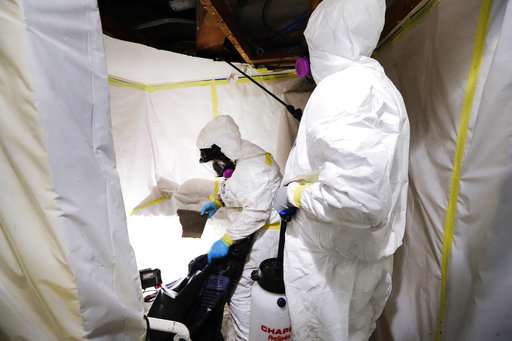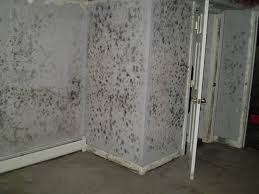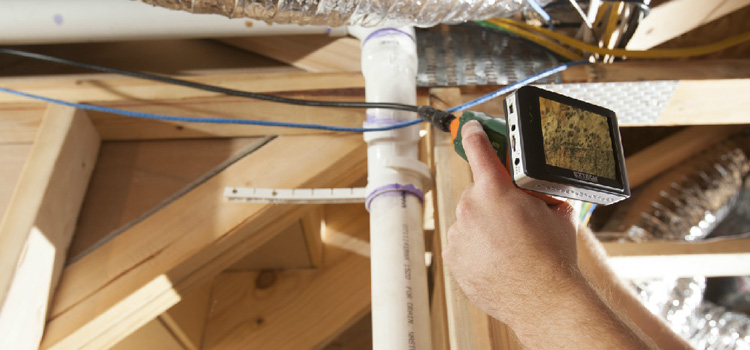Can you inspect for mold behind a wall?
Superman has x-ray vision, mold inspectors do not. So unless your inspector gains superpowers, how can they inspect obscured areas like inside of wall cavities for mold growth? have a number of different options on how can check the inside of wall cavities during mold inspections, ranging from totally noninvasive measures up to destructive methods.
Infrared Camera and Moisture Meter Inspections
An infrared camera is not x-ray vision and is not actually looking for mold. What an infrared camera is actually detecting is very small changes in surface temperature of the wall. If a material is wet, the water will evaporate from the surface of the material. Evaporation is an endothermic process, meaning that surrounding heat is absorbed in the process, which gets released. Because of that, the area where the evaporation is happening will appear cooler on the infrared camera image.
However there are other causes for a cooler surface on a wall, so it is important to use a moisture meter to confirm that the surface is actually damp. Moisture is a key indicator of mold growth. Mold needs moisture in order to grow on building materials, so if you can find moisture, there is a high chance that there may be associated mold growth on that material. Because an infrared camera is detecting temperature, using a moisture meter in tandem with an infrared camera can help us rapidly assess a room for moisture, and find the areas where mold may be most likely to be growing in a wall cavity. A thorough moisture analysis is a key step in any good mold inspection.
Borescope
A borescope is a tiny camera on a long flexible tube. A small opening, typically less than an inch across, can be cut into a wall to insert the borescope into the wall for observation. Attachments onto the end of the borescope can help direct the view to the reverse side of the wall. This method can be helpful in finding areas to cut into further or to sample from. However, due to obstructions such as insulation, general debris, and framing lumber, the borescope oftentimes does not give a clear view of the space.
Wall-Check Air Samples
Infrared cameras and borescopes are helpful tools in determining if there are any reasons for concern in walls, but they do not check for mold directly. To actually find out if there is mold growing in a wall cavity, a laboratory sample is needed. The least invasive way of collecting a sample inside a wall cavity is to take a wall-check sample. A wall-check is an air sample that is collected directly from inside the wall cavity. Once a site is selected a small hole, the diameter of a pencil, is drilled into the wall. An inner wall sampling attachment is put inside the hole to pull air from the wall cavity. Since only a small hole is needed, this minimizes the repair and potential exposure risks. Some limitations from wall checks are that they only test a small area of the wall cavity since studs and other obstructions can block free airflow inside the wall cavity, so proper site selection and a little bit of luck are crucial. It is also very easy to “overload” the sampling media with drywall dust and other debris, making it very difficult for the laboratory to analyze.

Reasons Why Scheduling Regular Mold Inspection Makes Sense
Mold spores are invisible to the eyes, and they travel through the air. Outdoors, mold can be helpful. It travels and naturally degrades plant materials. But, indoors mold is dangerous to health, and it may lead to respiratory problems, nausea, allergic reactions and headaches.
Each home has the potential for mold when spores are introduced in the right conditions. Spores usually flourish in damp and warm areas. The laundry rooms, bathrooms, and kitchens are particularly prone to growth. Mold often grows in the regions which are not visible like inside walls. If a pipe has a small leakage inside the wall, you may not even be aware of it for some time. Water can cause significant damage.
The big question is how to know you have mold in your house. The best way of determining if you have mold is with professional mold inspection and testing. The following are the benefits of carrying out regular mold inspection and testing.
Keeps Mold from Spreading
Mold usually spread very quickly. It takes less than 48 hours for it to start growing and can colonize in one day. Locating and remediating mold permanently can keep it from spreading throughout the home.
Help you Find Moisture
Even if you do not currently have mold growing in your house, you may have areasthat are a risk for mold. Mold inspections will help to reveal leaks and other areas of moisture in the home. Remediating such issues will help you avoid molds and prevent costly damages.

HOME MOLD INSPECTION SERVICES
WHAT IS MOLD AND WHY SHOULD I BE CONCERNED?
Tiny mold spores are in the air all around us, completely invisible to the human eye. These spores are incredibly tenacious, and can survive and even thrive in almost any conditions for long periods of time. When just one of these airborne spores lands on a damp or wet surface, it can begin to bloom.
These spores are what can cause illnesses, asthma flare-ups and other problems in people as they inhale these imperceptible particles into their nose and lungs. With their small size, mold spores can also be easily carried throughout your home, leading to further contamination in areas where mold isn’t presently growing, opening new areas to growth and spreading the problems to other areas of your living space. As a result, a mold colony in one location can easily spread to other areas, increasing the problem as these spores travel with drafts from your heating system, changes in pressure between rooms and levels of your home.
EXPERIENCED EXPERTS IN MOLD TESTING, MOLD ASSESSMENT & HELP IN MOLD REMEDIATION
comprehensive mold testing, mold assessment and mold abatement services, as well as home inspections to check for signs of mold problems. Their team is fully certified and licensed, backed with more than a decade of experience that they can use to solve your mold problems or address your concerns. team will visit your home and perform a thorough on-site inspection, reviewing all areas of your home for existing mold growth of signs of excessive humidity or moisture issues or other potential environmental hazards that could allow mold to take hold or cause other problems.
mold inspector may recommend further testing, including surface samples, bulk samples or indoor air quality testing to help determine the extent of issues. Samples that are taken will be overnight shipped to the leading mold-testing lab in the U.S., providing comprehensive results within 48 business hours of taking these tests, allowing their team to make rapid recommendations on how to address your home’s issues.
IT IS IMPORTANT TO MAKE SURE THE MOLD WILL NOT RETURN WITH A POST REMEDIATION MOLD TEST
To successfully complete a mold remediation project, a meticulous process must be followed to ensure that any colonies being removed don’t contaminate other areas of the home. Their team also follows up all removal projects with a third-party air quality testing company, providing outside assurance that the project has been performed completely and that your issues have been resolved. Third-party testing will also confirm that mold spore counts in your home have returned to acceptable levels, giving you final peace of mind that your mold problems are behind you.

Random Mold Tests
warning that investigators would be conducting random assessments at about 25 stores in the coming weeks “to evaluate contaminants in products on store shelves.” “Each sample will be tested for pesticides and total yeast and mold by a state- and ISO-certified marijuana testing facility. Results of their respective testing will be shared with each facility and will also be shared broadly within a write-up of results,” the announcement read.
Of the reports filed between September 9 and September 11, twenty listed at least one or more hold and quarantine orders for cannabis flower, shake or pre-rolled joints, an 80 percent failure rate. Each of those disciplinary actions was tied to plant matter testing above the maximum allowed for total yeast and mold.
The failed plant matter wasn’t typically covered in white and gray mold like an old piece of bread, but can still carry potentially toxic fungi that isn’t detectable by the naked eye. DDPHE officials would not confirm whether all 25 of the tests conducted within that two-day period were part of the planned assessment of potential mold and yeast issues, though they acknowledge that some were.
officials stress that the random assessment inspections were part of a long-planned research project to learn more about the shelf life and packaging of marijuana that had been announced in August, and were not targeting any specific dispensaries
The majority of the dispensaries that failed microbial testing had gotten the flagged marijuana products from wholesale providers, which were not named in the reports. Every commercial grow must send samples of each harvest to state-licensed laboratories for microbial testing before their products arrive at the stores
MOST IMPORTANT REASONS FOR MOLD INSPECTION BEFORE BUYING A HOME
The home is a beautiful thing, whether you’re moving from one to another, having one built, or moving out of your parents’ place. They’re the start of a new life and you will have some of the best and worst times there. If you have a family or you live by yourself, it will be a place where you spend most of your time and put your stuff.
The thing is, if you’re looking for less expensive houses on the market, it may be older altogether. Even if it’s not old, your house will be subject to all of the natural forces of the world. It’s possible that your house will get flooded, termites, or even mold. Older homes are especially susceptible to mold infestation, considering they were built to be air-tight. This is a perfect environment for the mold to grow.
Mold has caused problems for people over the past few decades than it ever has before, considering the way they were built. People have gotten deathly ill from mold. Since mold spreads through spores, they have even lost most of their belongings in order to rid themselves of mold. It can be toxic to humans. In fact, studies have proven that 65% of illnesses have been mold-related. The thing is, it can all be preventable with mold inspections!
All Homes Are Susceptible
As said above, many older homes have problems with air flow, leaving air-tight spaces for mold to grow. Even a leaking roof, leaking plumbing pipe in a wall or an AC drip pan or line clogging up and slowly dripping moisture where it would likely never been seen by the untrained eye. Water damage from a lack of proper home care is another little know, but huge player in mold infestations in the home.
However, even if your home is being built, it can still get mold! Home builders have begun going back toward that 1970’s method of keeping homes energy efficient when it comes to heating and cooling. This does save on utilities, which saves you money in the long run, but it also opens your house to possible mold infestation.